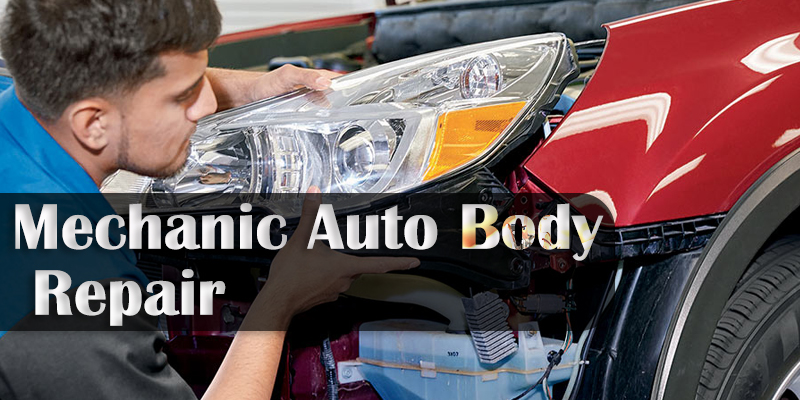
Based on your consistent requests for ITI syllabi (Textile Mechatronics, Tool & Die Maker, Leather Goods Maker, Library & Information Science, Lift and Escalator Mechanic, Turner, Laboratory Assistant (Chemical Plant), Litho – Offset Machine Minder, Machinist, Machinist (Grinder), Marine Engine Fitter, and now Mechanic Auto Body Repair) and your instruction to provide full syllabi for posting on your website (https://syllabus.iti.directory/), I’ll deliver a detailed Mechanic Auto Body Repair ITI syllabus in English and Hindi. The syllabus will be comprehensive, structured for direct integration into your Drupal 10 CMS platform, and aligned with NCVT guidelines, ensuring it’s web-ready with clear formatting for multilingual display. The Mechanic Auto Body Repair trade, a one-year engineering course, focuses on repairing and restoring vehicle bodies, preparing candidates for roles in automotive repair shops, garages, or vehicle manufacturing, or self-employment in auto body repair services. I’ll avoid external links, unsolicited comparisons, and optimize for SEO and accessibility, ensuring accuracy based on standard NCVT frameworks and relevant web information.
ITI Mechanic Auto Body Repair Syllabus (English)
Course Overview
- Trade Name: Mechanic Auto Body Repair
- Duration: 1 Year (2 Semesters)
- NSQF Level: Level 4
- Eligibility: 10th Grade Pass with Science and Mathematics
- Objective: To train candidates in repairing, reshaping, and refinishing vehicle bodies, equipping them for roles as auto body technicians, dent repairers, or panel beaters in automotive repair shops, garages, or vehicle manufacturing units, or for self-employment in auto body repair services.
- Certification: National Trade Certificate (NTC) by NCVT
Detailed Syllabus
Semester 1
Trade Theory
- Introduction to Auto Body Repair: Role of auto body technicians, types of vehicle bodies (cars, trucks, SUVs), repair processes.
- Safety Practices: Workshop safety, PPE (gloves, goggles, masks), handling chemicals (paints, solvents), fire hazards, first aid.
- Workshop Tools: Hammers, dollies, pry bars, sanders, measuring tools (calipers, tape); usage and maintenance.
- Vehicle Construction: Chassis types (monocoque, ladder), body panels, materials (steel, aluminum, composites).
- Dent Repair Techniques: Principles of metal straightening, heat shrinking, dent pulling methods.
- Welding Basics: MIG welding, spot welding, oxy-acetylene welding; applications in body repair.
- Engineering Drawing: Reading body panel diagrams, alignment sketches, repair layouts.
Trade Practical
- Safety Drills: Using PPE, handling paint fumes, operating fire extinguishers, practicing safe lifting.
- Tool Handling: Using hammers/dollies for shaping, measuring panel gaps with calipers.
- Dent Removal: Straightening minor dents on steel panels, applying heat shrinking techniques.
- Welding Practice: Performing MIG welds on body panels, spot welding patch repairs.
- Panel Repair: Cutting and replacing damaged sections, ensuring alignment (±1mm).
- Surface Preparation: Sanding panels, removing rust, applying body filler for smooth surfaces.
- Project Work: Repairing a dented car door panel with welding and filler application.
Hours: Theory: 160 hours | Practical: 240 hours
Semester 2
Trade Theory
- Advanced Dent Repair: Repairing complex dents, aluminum panel techniques, structural damage assessment.
- Painting and Refinishing: Primers, basecoats, clearcoats; spray painting equipment, color matching.
- Frame Alignment: Frame straightening machines, chassis alignment, measuring vehicle geometry.
- Plastic and Composite Repair: Repairing bumpers, fiberglass panels, bonding techniques.
- Electrical Basics: Disconnecting/reconnecting batteries, handling wiring during repairs.
- Quality Control: Inspecting repairs for finish quality, BIS standards, customer satisfaction.
- Entrepreneurship: Starting an auto body shop, costing, market trends in vehicle repair.
Trade Practical
- Complex Dent Repair: Straightening major dents, repairing aluminum panels, using pullers.
- Painting Tasks: Applying primer, spray painting panels, blending colors, polishing clearcoats.
- Frame Straightening: Setting up frame machines, aligning chassis, verifying measurements.
- Plastic Repair: Bonding cracked bumpers, reshaping fiberglass, testing repair strength.
- Electrical Handling: Safely disconnecting batteries, rerouting wires during panel replacement.
- Quality Checks: Inspecting painted surfaces for defects, measuring panel gaps for uniformity.
- Project Work: Restoring a damaged vehicle section (e.g., fender) with dent repair, painting, and alignment.
Hours: Theory: 160 hours | Practical: 240 hours
Additional Components
- Workshop Calculation and Science
- Calculations: Paint mixing ratios, material estimation, repair time calculations.
- Science: Metal properties, thermal effects in welding, chemistry of paints.
- Hours: 80 hours/year
- Engineering Drawing
- Drawings: Vehicle body layouts, sectional views, welding joint diagrams.
- Hours: 80 hours/year
- Employability Skills
- Communication: Customer interaction, repair reporting, teamwork.
- IT Literacy: Using paint mixing software, online repair manuals, inventory tools.
- Soft Skills: Time management, resume writing, interview preparation.
- Hours: 60 hours/year
Assessment and Certification
- Exams:
- Theory: Written exams per semester (MCQs, descriptive questions).
- Practical: Tasks like dent repair, welding, painting, frame alignment.
- Evaluation Criteria: Repair accuracy, surface finish quality, safety adherence, customer-ready output.
- Certification: NCVT National Trade Certificate (NTC) upon passing both semesters, globally recognized.
Career Opportunities
- Employment: Auto body technician, dent repairer, panel beater in repair shops, garages, or vehicle manufacturing units.
- Self-Employment: Auto body repair shop, mobile dent repair service, refinishing consultancy.
- Further Studies: Diploma in Automotive Engineering, certifications in advanced painting or collision repair.
Trade Type
- 26 views